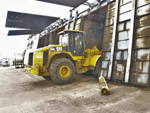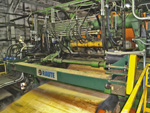Oregon plywood mill takes on new life
17 August 2009One of Oregon’s older plywood mills is emerging into another life under new owners, the Swanson Group of Glendale, Oregon. After buying the mill two year ago, they started converting it into a virtually new operation through refurbishments and some new equipment – and they haven’t shut down operations to accomplish the job.
Thorough detailed planning and job execution have been the secrets of Swanson’s success.
Mill manager Joe Andrews worked for the previous operators, McKenzie Forest Products, when Swanson took it over in July 2007 and improvement work started immediately.
The mill was on the century-old Booth-Kelly site which had gone through several ownerships when McKenzie picked it up. Their course of action was a common solution at the time – get away from commodity production and go with speciality niche products. McKenzie was 90% speciality, but that wasn’t 100% successful.
Swanson has taken a slightly different approach – roll with the market. The company is producing sheathing as something of a niche product when feasible, and also working with speciality products, including HDO and MDO in 8, 9, and 10ft lengths.
Ahead of the mill, Swanson replaced a Nicholson 22in debarker with a Nicholson 27in debarker and added controls, allowing one operator to control two log lines and sort for block diameters. In addition to a long-term agreement, they buy timber on the open market.
The mill had four dryers. Swanson pulled one out and Westmill Industries rebuilt two Coe dryers to make a 23-section, four-deck, jet tube unit and a 25-section, five-deck, longitudinal dryer. New insulated steel dryer floors were among the additions, including Sweed automatic feeders. The dryers offbear through a Ventek grade scanner, moisture meter, and Metriguard to a 12-bin Coe stacker rebuilt by ISN.
All this work has doubled the mill’s drying capacity with one less line.
Mr Andrews said the Sequoia moisture system from Ventek has been very good for the plant in optimising the dryers.
They started the lathe project even before the dryer work was completed. Swanson’s mill services group coordinated the project, which included log scanning and block laser pre-centring ahead of the Raute XY+ scanner. This is computer-controlled for the best recovery. A Raute pendulum charger feeds the lathe, which also has a new drive. Premier upgraded the lathe to ball screw drive. Central controls cue the system.
After the rebuild, the lathe can now peel six to 40in blocks so the mill can handle larger logs, which are less common these days, along with the more common small and medium sized blocks.
Veneer offbears through a Raute clipper and Ventek moisture meter to a Raute six-bin stacker.
Next, they tore out the lay-up line which Georgia-Pacific, owner at the time, installed in 1967. Swanson replaced it with a SparTek nine-station spray glue line. It includes hydraulic end-trim. The automatic line can handle double four-ply panels. An added station allows seven-ply panels. The control room is midway along the long line.
Mr Andrews commented, “Swanson laid out how they wanted the line to look and flow before they started. That is important when you’re putting brand new life in an old mill like this.”
Stackers and automatic feeders have minimised labour. The vision scanning increased accuracy.
The green-end work increased recovery, while employees in the dry end have been reduced from 40 to 13.
Meanwhile, the accident rate has been cut by more than 75%, mainly through less veneer handling.
Flow changes included product shipping. They took the rail spur out of the building and installed the lay-up line in its place. Two glue spreaders were retained for high-end products.
During all this, not a single production day was lost, nor did they mar their 290-day accident-free record.
Before stopping the lathe, Swanson had veneer stockpiled, augmented by veneer from Swanson’s original plywood plant in Glendale, Oregon, as well as veneer purchases. This supply kept them rolling while the lathe was revamped.
The mill has four vintage presses for the lay-up line and two for overlay, all of which have been rebuilt. These include three 24-opening Williams-White, Baldwin 30-opening, and Fjellman 12-opening presses. The latter pair handles the overlay side.
A roll-case line picks up panels from the lay-up line and glue spreaders and takes them to the pre-presses and on to the presses. With the existing 4x8ft and 5x10ft presses the plant can produce 4x8ft to 5x10ft panels after a 10-foot sander is installed.
Production is in panels from 1⁄4 to 1-1⁄2in thick, and up to 11 plies.
This is Douglas fir sanded, Douglas fir siding and speciality industrial plywood, as well as a full line of overlay plywood, MDO (medium density overlay) concrete form, HDO (high density overlay) concrete form and marine grade. Cut-to-size is available in 1⁄4in increments between 8 and 10ft.
The mill also produces some high-grade hardwood-faced panels for siding and industrial use.
Maximum production for the revamped mill could be 180 million ft2, 3⁄8in basis, annually. It is now 2.4 million ft2 per month, with 123 employees including production, maintenance and office staff.
“Even during tough times, it’s exciting for me to be part of the continuous improvement of this facility. I have to hand it to the company, how dedicated they are to the people and to this whole process,Mr Andrews concluded,
Swanson is a family owned company with five Oregon mills—the original Glendale plywood plant, Eugene
plywood and three stud mills. It
produces plywood, dimension lumber and studs and also has a helicopter
company involved in logging and
forest firefighting.
The firm’s output is certified by SFI, the Sustainable Forestry Initiative,
which promotes and monitors sustainable management.
Steve Swanson is company president and ceo; Chuck Wert is chief operating officer; and John Stembridge is vice president for sales and distribution.


